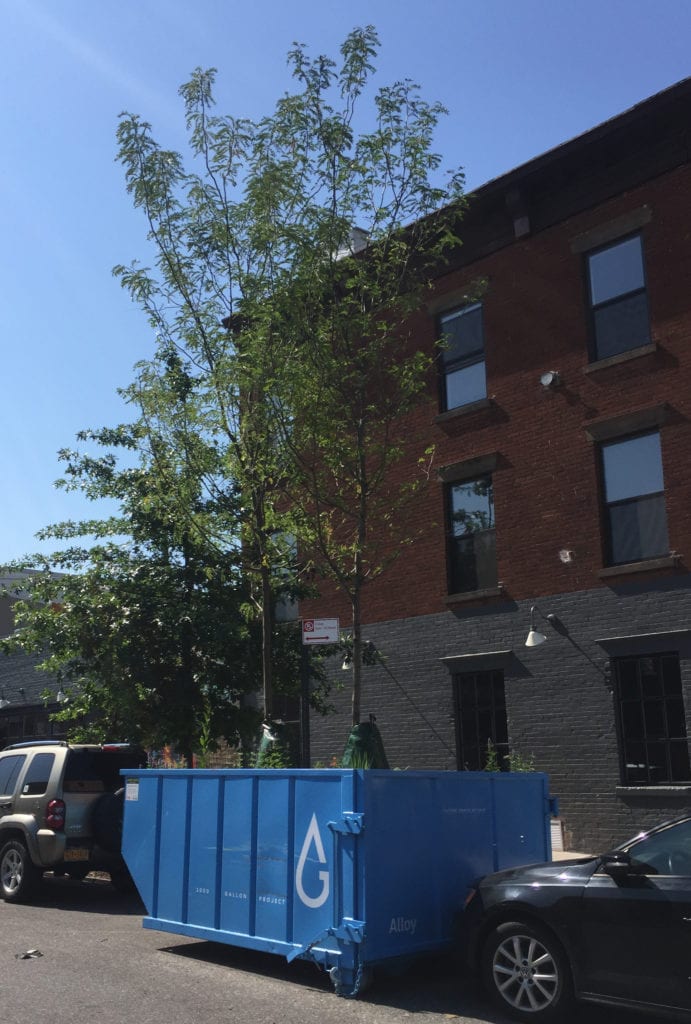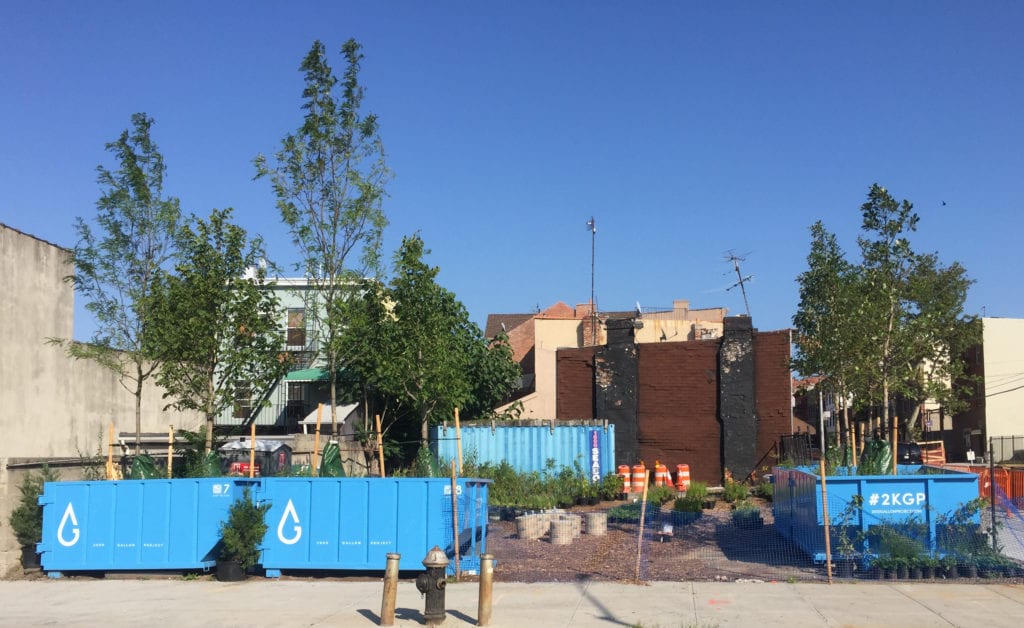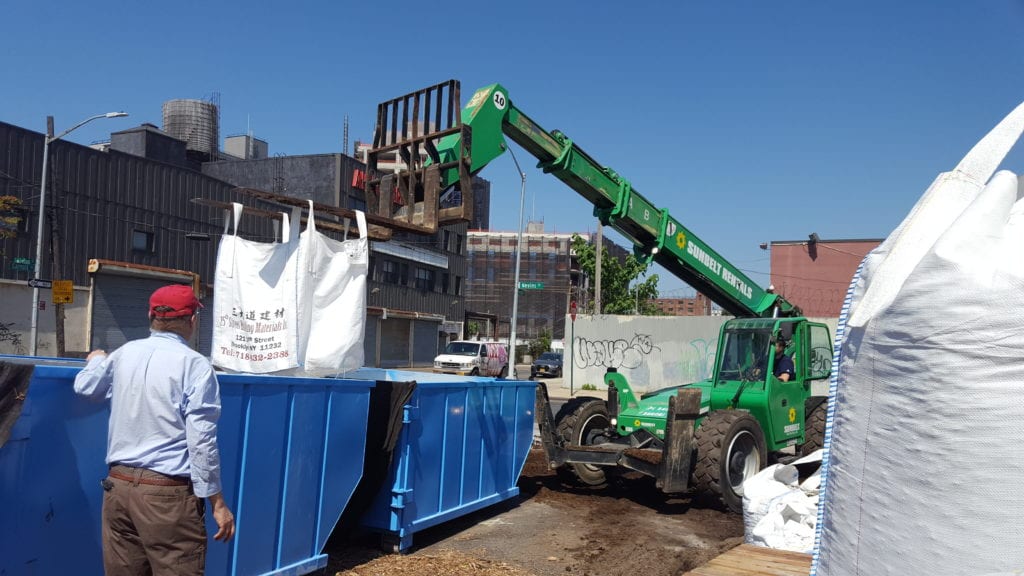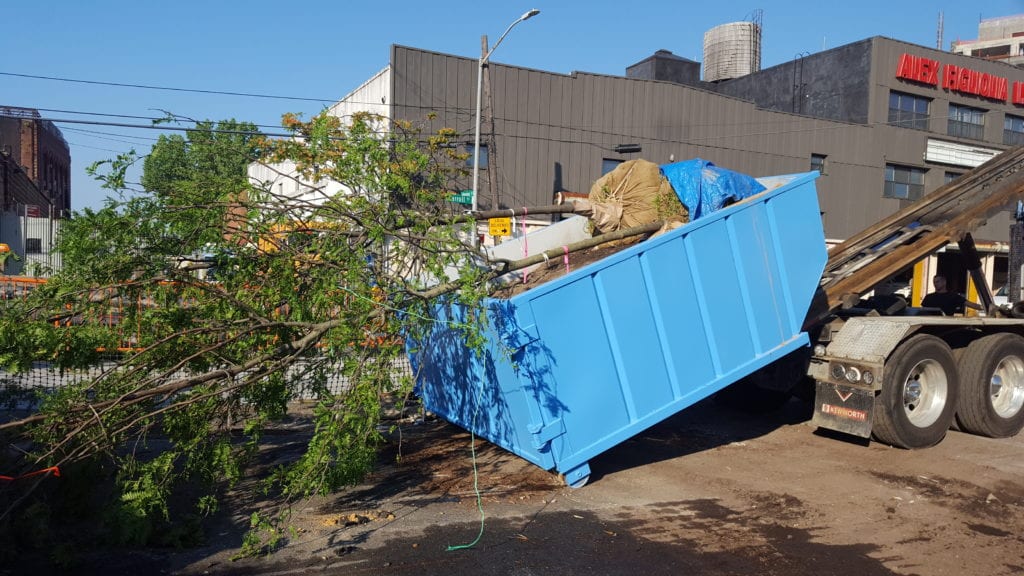by Nick Shannon
The 2,000 Gallon Project envisions a healthier Gowanus community through a conventional dumpster planted with native trees and perennials. Each dumpster provides a visual representation of the amount of stormwater a bio-swale can handle during a storm event and brings attention to the issue of Combined Sewage Overflows (CSO) emptying into the Gowanus Canal. The project highlights the importance of green infrastructure in New York City’s Gowanus Canal watershed as a way to reduce added pollution emptying into one of the most polluted waterways in the U.S.
A joint project between the developer Alloy and the Gowanus Canal Conservancy (GCC), the 2,000 Gallon Project is an educational tool and a feature that reminds the neighborhood that each of us can take action to protect the watershed. Whether it is volunteering with the conservancy, installing a rain barrel, or taking shorter showers, everyone has the potential to decrease the burden on the sewage system and to limit the amount of raw sewage emptying into the canal.
Gowanus Neighborhood
The Gowanus Canal is a highly urban and polluted water body. Historically, the Gowanus Canal was a tidal estuary surrounded by farms and mills – a functioning ecosystem before development. When the creek was turned into a canal, it was used to drain the marshland and create a commercial transportation hub that sparked the growth of adjacent industries. At the time, there was little environmental regulation, and waste from the new industries was discharged into the canal without treatment, contaminating the water with industrial pollutants such as coal tar and heavy metals that are still apparent today.
The industrialization and urbanization of the Gowanus neighborhood is still a major part of its identity today, and the area still hosts local manufacturing and industrial businesses along the canal. But the area is rapidly changing with pressure for residential development.
The Dumpsters
The 2,000 Gallon Project consists of ten 2,000 gallon dumpsters that are being used as temporary nurseries and visualization tools to grasp how much water a bio-swale can handle during a storm event. Six of the dumpsters are scattered throughout the neighborhood, and four of them reside at 431 Carroll Street, the site of a pop-up nursery and stewardship center managed by the GCC. The GCC holds volunteer workdays, rainwater harvesting workshops, and urban ecology lectures to get people in the community involved with protecting their environment and to encourage a healthy canal watershed. Click here to find the dumpsters on a map.
The dumpsters were installed under the DOT’s Street Seats program that encourages the use of parking spaces for pop-up seating to facilitate a social public space. Two of the dumpsters have seating next to them, and the network of dumpsters spread across the neighborhood encourages community conversation and interaction focused on the health of the Gowanus Canal watershed and environmental stewardship.
Volunteers are a huge part of the 2,000 Gallon Project. From moving the trees into the dumpsters to watering them, volunteers and the GCC staff ensure a functioning project. In order to make any change in such a degraded environment, it really does take a community to come together to make small changes that eventually add up to a quantifiable positive impact.
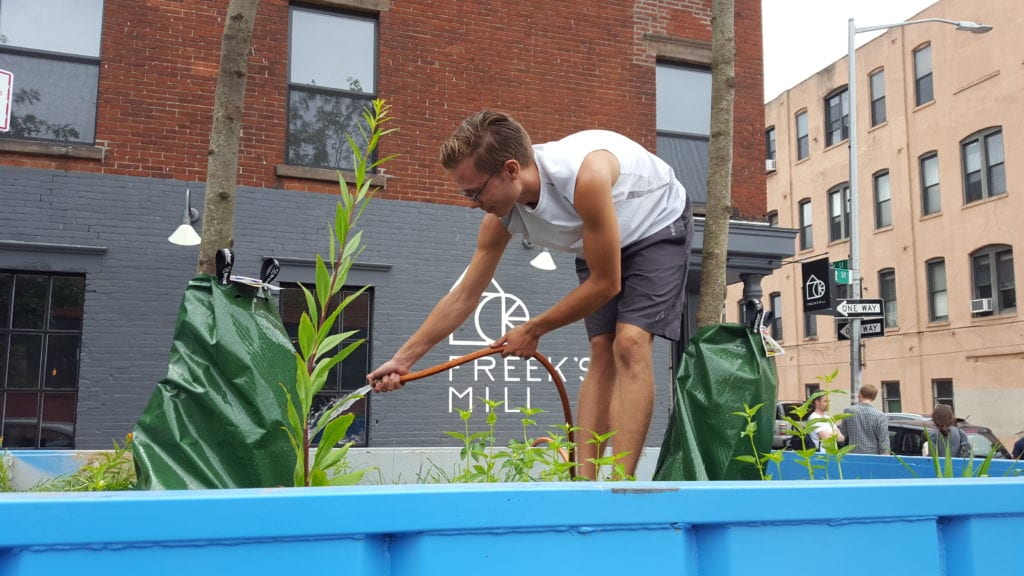
Volunteers are a vital part of the 2,000 Gallon Project’s success and help water plants from adjacent fire hydrants.
What’s in the Dumpsters?
Each of the 10 dumpsters holds two trees and a mix of perennials. The plants are native, and were carefully selected based on their performance in the Gowanus neighborhood to ensure survival when planted on the street.
The trees in the dumpsters are:
Honey Locust Gleditsia triacanthos
American Basswood Tilia americana
Swamp White Oak Quercus bicolor
The perennials currently thriving in the dumpsters are:
Honeysuckle Vine Lonicera sempervirens ‘Major Wheeler’
Virginia Creeper Parthenocissus quinquefolia
Showy Goldenrod Solidago speciosa
Giant Hyssop Agastache ‘Black Adder’
Butterfly Weed Asclepias tuberosa
New England Aster Symphyotrichum novae-angliae ‘Purple Dome’
Common Milkweed Asclepias syriaca
Little Bluestem Schizachyrium scoparium ‘Standing Ovation’
Prairie Dropseed Sporobolus heterolepis
Purple Love Grass Eragrostis spectabilis
Adam’s Needle Yucca filamentosa
All of these plants are planted in fill soil mixed with compost. A layer of mulch is being added this week to incorporate more nutrients to the soil and help it retain water more efficiently. Every tree has a watering bag attached to it that is filled up using water from adjacent fire hydrants. The perennials are watered with the fire hydrants as well.
Street trees improve air quality and provide cooling shade and habitat for birds and wildlife. They also soak up stormwater. Mature trees manage up to 4,000 gallons of stormwater per year, the equivalent of two dumpsters. The Gowanus neighborhood has a lack of street trees, and it is hard to walk on the streets during the summer. The 2,000 Gallon Project serves as a nursery for 20 new street trees that will be planted this fall on streets throughout the neighborhood.
Pollution and Clean Up
Combined Sewage Overflows are the main source of pollution still entering the canal today, and green infrastructure is an easily-implemented solution to reduce the amount of raw sewage emptying into the water. Three hundred seventy-seven million gallons of combined sewer overflow enter the Canal each year, and each 2,000 gallon dumpster provides visual representation of the immense scope of the problem. There is not a single solution, but rather a collection of small-scale interventions that can add up to make a difference.
The dumpsters are only part of the story; they are a small-scale intervention that is making a difference while planning for larger infrastructure is under development. People are awakening to the problem of the contamination and are starting to respond to the canal’s environmental and health concerns. Today, the health, smell, and water of the canal are starting to turn around.
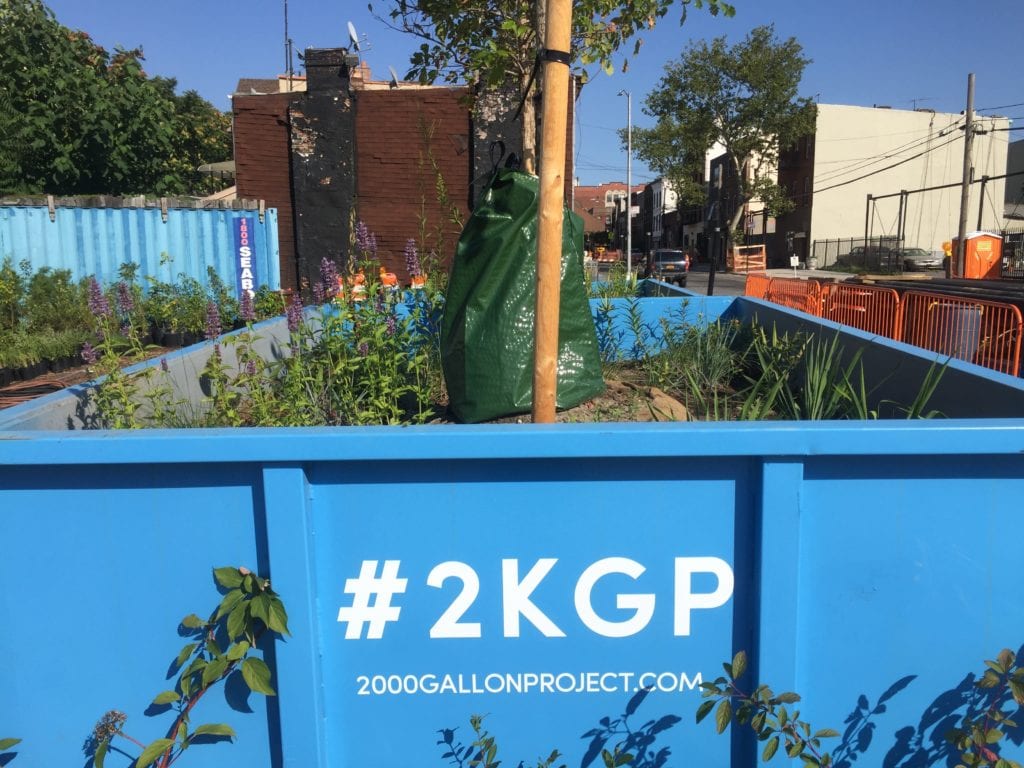
Trees from the dumpsters will be transplanted into tree pits around the neighborhood where they will continue to provide ecosystem services.
The Gowanus Canal was recently designated a superfund site, which has sparked action to clean up the contaminants. In the next decade, the canal will be dredged to clean up 10 feet of contaminated sediment. The flushing tunnel at the mouth of the canal was recently upgraded by the EPA and is now more efficient in bringing oxygenated water from the East River. This has improved the smell of the water, and people are starting to change their perception. Two new stormwater tanks are also being built that will greatly reduce the amount of raw sewage that overflows into the canal. These projects, in conjunction with a network of bio-swales, rain gardens, and tree pits, will greatly decrease the amount of stormwater contributing to combined sewage overflows.
Bio-swales
The dumpsters are a visualization of the water one bio-swale can handle during a storm event, so what are the functions of these bio-swales?
Every new bio-swale will keep 2,244 gallons of stormwater out of the combined sewer system. The surface runoff from the road carries contaminants and is directed to the bio-swales through a curb cut, infiltrating the water into the soil through a gravel and sand retention base that cleans the water while keeping it out of the stormwater pipes.
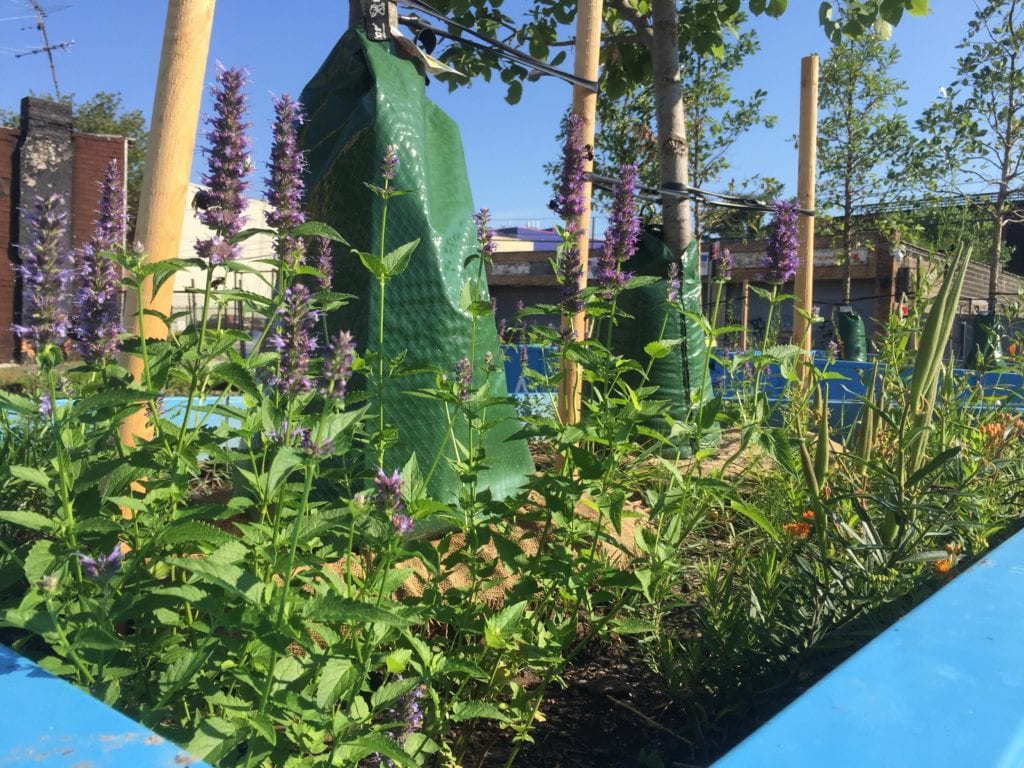
Every new bio-swale installed in the watershed prevents slightly more stormwater than could be contained in a dumpster from entering the combined sewer system.
There are currently over 91 bio-swales in the Gowanus watershed that prevent over 204,204 gallons of runoff from entering the stormwater/sewage system. The Gowanus Canal Conservancy plans to encourage the installation of more bio-swales in the watershed and continues to maintain them with the help of local community stewards.
This relatively low-cost network of green infrastructure is effective in cleaning runoff while holding it back from entering the combined sewage system. This is only one part of the larger solution. One size does not fit all, and in conjunction with rain barrels, rain gardens, tree pits, and stormwater tanks, change is happening.
Future Steps
The 2,000 Gallon Project is not just a temporary installation – it will have lasting effects long after the dumpsters are gone. The trees in the dumpsters will be planted around the neighborhood in vacant tree pits to increase the canopy cover, provide shade during the summer, soak up more stormwater, and provide critical habitat.
A cleaner Gowanus is made possible through efforts like this, paving the way for increased biodiversity and cleaner air and water in the future. We need to protect our environment for future generations, and starting small but thinking big is the only way to get there.
About the Author
Nick Shannon is in his fifth year of a Bachelors of Landscape Architecture at SUNY College of Environmental Science and Forestry in Syracuse, NY. He will be executing an independent research project about streetscape design and urban mobility in Buenos Aires, Argentina this fall. Also a writer for Landscape Architects Network, Nick is interested in the role of the landscape architect in shaping cities and how design can improve the quality of life of its end users.
Each author appearing herein retains original copyright. Right to reproduce or disseminate all material herein, including to Columbia University Library’s CAUSEWAY Project, is otherwise reserved by ELA. Please contact ELA for permission to reprint.
Mention of products is not intended to constitute endorsement. Opinions expressed in this newsletter do not necessarily represent those of ELA’s directors, staff, or members.

